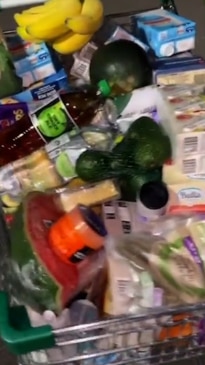‘Absolute joke’: Woolies customer shocked at $380 receipt for small trolley of groceries
A fed-up Aussie customer has shared their receipt after being stunned by the price of their weekly supermarket shop - but not everyone is on their side.

A Woolworths customer has expressed disbelief at Australia’s shockingly high cost of living after a small trolley of groceries cost nearly $400.
The customer shared a video on social media of his haul from the Lake Munmorah Woolworths on the NSW Central Coast.
“Have a go at this,” he says in the viral clip.
The trolley can be seen loaded with items including toilet paper, lactose free milk, bread, butter, soft drink, bananas, avocados, melons, mixed nuts, ice creams and fruit juice boxes.
“It’s one of the smaller trolleys, too,” he adds.
“Some bacon, did get a baby formula in there, that was $30 but even still. There’s a couple packets of sausages in there. This just cost me almost $400. This is f**ked. This is an absolute joke. Look at this receipt. F**k me.”

The receipt shows the total came to $384.63.
“$400. Now imagine being on the pension with $1096 a fortnight and you have to pay rent, power and food etc. Lots of Aussies are a paycheck away from homelessness,” one user commented.
Another said, “I was saying the other day to my family. The small trolley cost me $300 and a few years before Covid a big full trolley would be $200 to $250, roughly speaking from a weekly shopper with three teenagers. WTF?”
A third said, “It’s 100 per cent going to get worse. A lot of people are going to have to get a lot better at shopping to weather it.”
Some people suggested the man shouldn’t be surprised at the price.
One wrote, “A few big ticket items in there. Baby formula ($30). Avocados ($7). Bulla Splits (big box). Fancy mini bananas. Organic nuts/seeds. Party pies ($18). Soothers ($10). Fruit (sugar) juice ($8). Shop better.”

Another said, “Bottled water. Dry ginger ale. Little boxes of juice. Loads of luxury spending there.”
A Woolworths spokesman said the supermarket was “acutely aware of the pressure that’s being placed on Australian families through cost of living increases, whether they are our customers or our team members”.
“And we’re doing more everyday to help customers spend less with us,” he said.
“That’s why we have more than 6000 weekly specials, more than 3000 products on our Low Price program, dropped the price of 150 products to help customers celebrate the festive season. Our large range of own brands also help customers save on a wide variety of products without compromising on quality and taste.”
The average Aussie household spent $182 on their weekly grocery shop in October 2023, according to comparison website Finder’s Consumer Sentiment Tracker.

Two in five (39 per cent) respondents said their grocery shopping was causing them financial stress. That number doubled over the last three years, from 19 per cent in October 2020.
Finder analysed the cost of trolley of comparable items across Woolworths, Coles and Aldi, finding the most expensive shop cost 7 per cent more than the cheapest option.
The total price for a basket of 46 goods from Aldi came to $199.69, followed by Woolworths at $208.85 and Coles at $214.32.
“Grocery bills are putting significant strain on household budgets,” said Graham Cooke, head of consumer research at Finder.
“Food prices have continued to rise in recent years, with basic staples like cheese, bread, dairy and oils experiencing some of the biggest price rises of 10 per cent or more. Households are at breaking point, with many changing how and where they shop in order to put food on the table.”

Mr Cooke said there were ways to keep the cost of your shop down, such as always using a shopping list and going towards the end of the day when you are more likely to find discounted items.
Inflation increased 5.4 per cent over 12 months to September, according to the Australian Bureau of Statistics (ABS), as high petrol costs, the tight rental market and soaring electricity costs pushed consumer prices higher.
The latest Consumer Price Index also showed a stunning 16 per cent rise in the price of cheese. Prices for dairy products across the board rose by 12.1 per cent due to elevated farmgate milk prices, the ABS said, while other operating costs including electricity and labour also contributed.
Aside from cheese, other increases in dairy staples were also significant. Ice cream prices rose 11.2 per cent, while milk prices rose 5.5 per cent over the same period.
More Coverage
But not all items in the supermarket trolley were marked up — fruit and vegetable prices fell 6.4 per cent in the year to September, the ABS data showed.
— with NCA NewsWire






